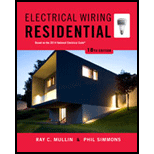
Electrical Wiring Residential
18th Edition
ISBN: 9781285170954
Author: Ray C. Mullin, Phil Simmons
Publisher: Cengage Learning
expand_more
expand_more
format_list_bulleted
Concept explainers
Question
Chapter 13, Problem 1R
To determine
Mention the circuit that is connected to the living room.
Expert Solution & Answer
Answer to Problem 1R
The living room is connected to the circuit B17.
Explanation of Solution
Discussion:
The feed for the lighting branch circuit of living room is connected to circuit B17 that originates at the main Panelboard B. The circuit B17 is a 15-ampere branch circuit that provides an overcurrent protection and an arc-fault protection using a 15-ampere arc-fault circuit interrupter (AFCI) circuit breaker in Panelboard B, as required by the NEC 210.12(A).
Conclusion:
Thus, the living room is connected to circuit B17.
Want to see more full solutions like this?
Subscribe now to access step-by-step solutions to millions of textbook problems written by subject matter experts!
Students have asked these similar questions
Don't use ai to answer I will report you answer please
Draw the digital modulation outputs, ASK (Amplitude Shift Keying), FSK (Frequency Shift
Keying) and PSK (Phase Shift Keying). For baseband and carrier frequency as shown
BASESAND
0
CARRIER
101
wwwwwwwwwwwww
Don't use ai to answer I will report you answer
Chapter 13 Solutions
Electrical Wiring Residential
Ch. 13 - Prob. 1RCh. 13 - Prob. 2RCh. 13 - Prob. 3RCh. 13 - How many wires must be run between an incandescent...Ch. 13 - Complete the wiring diagram for the dimmer and...Ch. 13 - Is it possible to dim standard fluorescent...Ch. 13 - a. How many wires must be run between a...Ch. 13 - Explain why fluorescent lamps having the same...Ch. 13 - What is the total current consumption of the track...Ch. 13 - Prob. 10R
Ch. 13 - Prob. 11RCh. 13 - Electronic dimmers of the type sold for...Ch. 13 - Prob. 13RCh. 13 - A layout of the outlets, switches, dimmers, track...Ch. 13 - Prob. 15RCh. 13 - Prob. 16RCh. 13 - Prob. 17RCh. 13 - Prob. 18RCh. 13 - May a standard electronic dimmer be used to...Ch. 13 - Prob. 20RCh. 13 - Why should the power be turned off when hooking up...
Knowledge Booster
Learn more about
Need a deep-dive on the concept behind this application? Look no further. Learn more about this topic, electrical-engineering and related others by exploring similar questions and additional content below.Similar questions
- please explain step by step how ti solve these problems and include good explanations. I am most confused with graphing. Thank you, I will give positive feedback. The rest of the questions to this problem are submitted as a new questions due to the multiple part limitarrow_forwardDon't use ai to answer I will report you answerarrow_forwardThis is the last two questions of a previous question I just sent. Please show step by step with clear explanations as to what to do for these questions. I am very confused. Thank you, I will give positive feedbackarrow_forward
arrow_back_ios
SEE MORE QUESTIONS
arrow_forward_ios
Recommended textbooks for you
 EBK ELECTRICAL WIRING RESIDENTIALElectrical EngineeringISBN:9781337516549Author:SimmonsPublisher:CENGAGE LEARNING - CONSIGNMENT
EBK ELECTRICAL WIRING RESIDENTIALElectrical EngineeringISBN:9781337516549Author:SimmonsPublisher:CENGAGE LEARNING - CONSIGNMENT

EBK ELECTRICAL WIRING RESIDENTIAL
Electrical Engineering
ISBN:9781337516549
Author:Simmons
Publisher:CENGAGE LEARNING - CONSIGNMENT